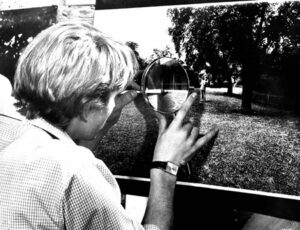Antonioni’s “Blow-Up” – “The Unbearable Lightness of Being”

Title: “Blow-Up”
Release Date: 1966
Director: Michelangelo Antonioni
Cast: David Hemmings, Vanessa Redgrave, Sarah Miles, Jane Birkin, Peter Bowles, Veruschka von Lehndorff, John Castle, Gillian Hills
“Blow-Up”, one of Michelangelo Antonioni’s most important films, is a moving picture of the spiritual emptiness of modern man. In the postmodern reality, in which all the truths of the old world have been consigned to oblivion, even death loses its real and grievous dimension.
“Blow-Up” from 1966 was the first English-language film by the Italian master, who had earlier gained popularity as the director of “L’Avventura”, “La Notte” and “L’Eclisse”. Antonioni’s film is set in London in the 1960s, among the artistic bohemia. It is a time of intense social change and sexual revolution. The main character of the film is a young, successful fashion photographer, Thomas (David Hemmings), who, while taking pictures in a park, accidentally records a meeting of two lovers. A woman (Vanessa Redgrave) notices the intruder and wants to snatch the camera from him at any cost.
When Thomas returns home, the stranger unexpectedly visits him and tries to negotiate to get the photos. She even offers her charms to the photographer in exchange for the film. Seeing the woman’s determination, he hands her a roll of other photos and, after she leaves, develops the photographs from the park. Zooming in on subsequent frames, Thomas discovers that a man was murdered in the park and that the woman was only feigning affection in order to lure her would-be lover to a secluded spot and make it easier for the murderer to shoot the victim. Thomas returns to the crime scene where he finds the victim’s body. However, he does not notify the police, but wants to persuade a writer friend to photograph the body together. During a night wander around the city in search of his friend, the photos from the park disappear from Thomas’s house, and when the photographer goes to the park in the morning, the body is gone. The resigned protagonist joins a tennis match where the participants bounce an imaginary ball between themselves.

“Blow-Up” – the destruction of criminal intrigue and the failure of truth
Structurally, Enlargement is a film similar to “L’Avventura” (1966) with Monica Vitti, with which Antonioni’s great career began. What we have here is a destruction of the criminal plot pattern. There is a murder, there are suspects, there is the beginning of an investigation, but in the end nothing is explained. The viewer’s expectations remain unsatisfied. Antonioni foregrounds the unknowability of the world and the failure of the human quest to discover the truth.
The situation is further complicated by the fact that we move in a world of appearances, just like Thomas, who learns what really happened in the park only by enlarging the photographs. A careful look at the world leads to its unmasking, but at the same time it is impossible to discover the core of the matter. For the photographs, when enlarged too much, become an abstract image in which no concrete shape can be recognized anymore.
At the same time, Antonioni in “Blow-Up” makes interesting observations about contemporary image culture and the role of the media. Thomas is a man who cannot look at the world without a photographic filter, everything that he experiences, that delights or moves him, he must immediately capture with the camera. Therefore, as Susan Sontag says, in the contemporary world it is photography that gives meaning to reality, decides what has meaning, and determines the rank of its objects.

On the other hand, everything that is not in the photograph loses almost its real existence, just like the crime committed in the film. When the evidence in the form of photographs disappears, the whole event loses its meaning. Antonioni in “Blow-Up” also shows how photography can become a tool of manipulation. When only what we can show in the frame is real, it is possible to create any narration about the world and show it as the only right truth. In this way photography becomes an instrument for falsifying reality; instead of bringing the world closer, it actually distances man from the truth. It sits between man and reality, it is a substitute for real seeing.
“Blow-Up” – decadent London
Antonioni’s “Blow-Up” is also a depiction of decadent London in the midst of the sexual revolution of the 1960s. Thomas, flaunting himself in his Rolls-Royce, is a typical representative of bohemia, engaged in both commercial and artistic activities. His atelier is full of beautiful models, led by the famous Veruschka. The scene of photographing the celebrated European model is one of the most famous scenes in the film. It has both a literal and metaphorical dimension, contains clear erotic allusions, and refers to the contemporary culture in which the female, attractive body becomes a commercial commodity.
“Blow-Up” also features other representatives of the artistic world: painters, writers and the iconic British band of the time, The Yardbirds. There is a brilliant scene at a concert in the Ricky Tick Club, when the legendary Jeff Beck smashes an electric guitar and throws its remains into the crowd, which immediately starts a mad fight for this relic. The lucky winner turns out to be Thomas, but as soon as he walks away with his loot, he throws the guitar onto the London pavement. Passers-by pass the “precious” object indifferently. In this way, Antonioni once again masterfully draws attention to the relative value of things in contemporary culture.

“Blow-Up” – the world after the “death of God”
“Blow-Up” shows the terrifying axiological emptiness of the new social formation. Its best illustration is the main character. Although he has access to almost all the pleasures of life – he is successful at a young age, has money, fame, and any woman he desires – his existence is blatantly boring. Nothing gives Thomas pleasure, and his inner stagnation makes him rather repulsive to look at. In his film, Antonioni portrays the reality after the Nietzschean death of God, i.e. a world in which traditional ethical values have been overthrown, but instead of the expected freedom, an abyss of spiritual emptiness has appeared.
It can be seen in Thomas’s life, revived only for a moment during work or casual sex. In such a shallow existence, the only thing that can shake the protagonist is death. The mystery he encounters spurs Thomas into action. Nevertheless, his private investigation gets blurred in a nighttime escapade through the city’s labyrinthine maze and ends when he hits a drug party. He gives in to temptation of temporary ecstasy and instead of returning to the scene of the crime or calling the police, he reaches for marijuana and only wakes up in the morning when all traces of the murder have been erased.
“Blow-Up” – illusion instead of truth
The final scene of “Blow-Up”, when Thomas joins a pair of mimes playing with an imaginary ball, is a kind of theatricalization of reality. The game is watched with tension by a group of spectators who pretend that everything takes place for real. So it is not important what is true, Antonioni seems to say. For truth is a kind of universal agreement. Perhaps we all agree to some extent that illusions and appearances can replace reality, which is too cruel or simply impossible to comprehend.
Literature:
A.Grabicz, “Kino, wehikuł magiczny. Przewodnik osiągnięć filmu fabularnego. Podróż trzecia. 1960 – 1966”, Kraków.
